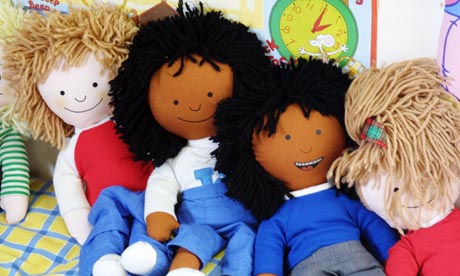Folks, Here's an interesting article in the Guardian about an effort in CO that seems noble to me in principle, although I would hope that daycare centers would think of doing this on their own without needing to be forced.
I agree that it is a small token in the grand scheme of things, but these small signals to our young people add up. They are watching us and learning from our decisions, and making lots of these kinds of small choices over time will help shape their viewpoints going forward.
Ikea has cute options in this department, by the way.
thanks, Ingrid
http://www.guardian.co.uk/commentisfree/cifamerica/2011/jul/13/colorado-racially-diverse-dolls
Colorado's tolerant call for racially diverse dolls in daycare centres
It may seem a token gesture, but Colorado's plan to make child care centres provide dolls representing three races will have a positive effect

Colorado's Department of Human Services is proposing rules for child care centres requiring them to have dolls of three different racial appearances among their toys. Aside from some accusations of impracticality (the list of proposals also includes limits on a child's juice intake and a ban on adult carers wearing sleeveless tops) what the rules are aiming for with the doll initiative is broadly admirable.
There is a buoyant optimism in the idea that giving children two extra colours of doll to cuddle, throw, and mash soggy bread into the mouths of will subtly inculcate them with ideals of equality. Are racially sensitive toys rendered irrelevant by an unequal society, or are such incremental improvements still significant in their own right?
In Tina Fey's recent memoir Bossypants, she writes about attempting, through books and toys, to reverse the effect on her daughter of narrow cultural definitions of prettiness. Fey changes the word "blonde" when reading her child a story to "yellow," feeling this is only fair when brunette hair is nearly always "brown". Her daughter has a doll which is reversible, one side Snow White, the other side Sleeping Beauty. Fey leaves the doll Snow White side up (brown hair) every night, and her daughter will always flip the toy so that Sleeping Beauty (yellow hair) is showing. When Fey asks why, the toddler replies: "I don't like her hair." Fey remarks on how astonishingly early the reverence for blonde begins, and also jokes: "I did this experiment so frequently and consistently I should have applied for government funding."
Dolls have in fact been used, in experiments carried out in 1939 by Kenneth and Mamie Clark [pdf], to divine children's attitudes towards their own appearance. In this case the enquiry had a racial slant, as black children were offered a choice between black dolls and white dolls. When asked which doll they would like to play with, which doll was "nice" and which doll was "a nice colour", a sizeable majority of children chose a white doll. Asked which doll "looks bad". they chose a black doll.
The experiment was resurrected in 2005 by New York filmmaker Kiri Davis who, although with a much smaller sample, found results that were depressingly similar to those recorded 60 years earlier. These experiments make clear a deep-seated and saddening stigma, but the children in the first experiment were barely two generations away from slavery and we know little of the educational environment of the Kiri Davis group. Studies have yet to examine whether the presence of a mix of dolls in a modern daycare centre over the course of years would alter the answers to the questions.
One can understand why the rules put forward by Colorado's Human Services Department might seem petty; bureaucratic directives tend to sound that way because they have to go into specifics in order to be enforceable. But required diversity, even in such a small area, is powerful. Children shouldn't be lectured to about egalitarianism, but having a play-corner which unobtrusively contains dolls of different ethnicities is surely only going to improve on a cast of homogenous toys.
Applying adult squeamishness about political correctness to children's moral education is wrong-headed. There is a show on CBeebies, the BBC's channel for children under six, called Same Smile, in which presenter Nisha Anil travels around Britain on a bicycle with three stuffed toy pandas (one green, one red, one purple) to meet children from different backgrounds. To an adult who can see the philosophy which underlies the programme it can seem to be bludgeoning home the message of equality. But to a child the interest is in seeing other children talk about their lives and home towns, and the charm is that without it being directly addressed the idea of tolerance is conveyed.
It has been pointed out that Colorado is a very white state, as if this invalidates the proposal, but this should really make no difference. It should even make it more important to stress early in life through play that most areas of the country are not so uniformly Caucasian.
Half the children in the Clark doll experiments were still in segregated schools, the other half may have been in mixed classes but were still living in an America where lynchings were a regular occurrence. Kiri Davis only interviewed 21 children. Who knows what the results would be if black children, as well as children in the majority racial group, see throughout their education non-white characters in equal roles in books and games? Certainly the focus of policy should be on addressing serious inequality, on the massive discrepancies in education level and earnings between groups.
The three dolls idea is, in comparison to these vast problems, tokenistic, but small changes are still changes. Minor schemes like the one put forward in Colorado can have a positive effect on the most impressionable portion of the population. Hopefully by the time the beneficiaries of this decision, and other rulings like it, are older, society will be starting to match their high expectations.
No comments:
Post a Comment